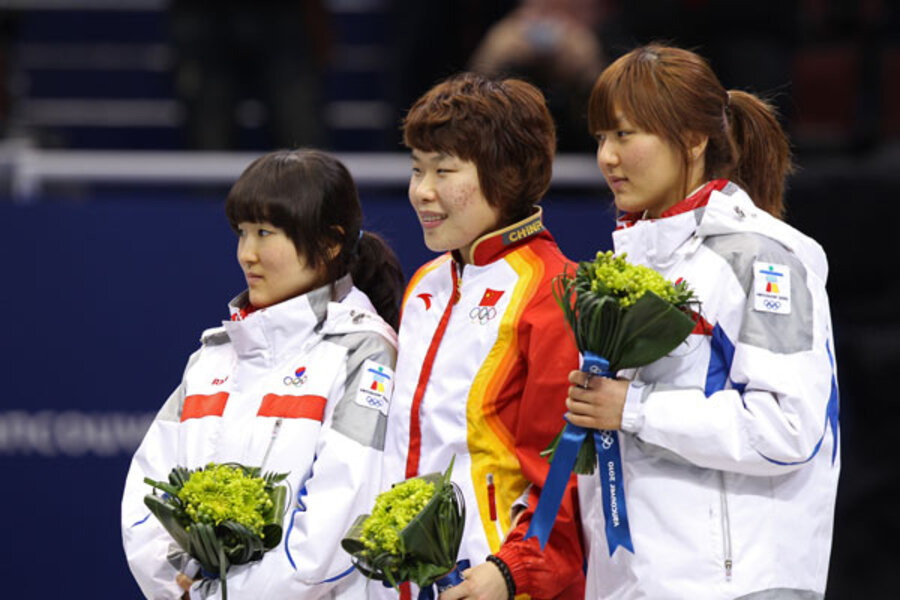Olympic flowers: The story behind the bouquets given to medal winners in Vancouver
Loading...
Like millions of people around the world, I was hopelessly addicted to viewing the world’s top athletes showcase their very best at the Vancouver Olympics.
The moment Evan Lysacek, a native of my hometown of Naperville, Ill., raised his arms in victory to a first place finish in men’s figure skating, triumph and unity was shared among all Napervillians. The kid who grew up skating at the rink just down the road from my house was now a medal-winning Olympian.
But wait. Did you happen to notice the bouquets given to the medal winners? Not the most telegenic bouquet I’ve ever seen. From my perspective sitting on the couch, the design looked a bit severe and monotonously green. From my husband’s perspective, it looked a bit liked a stalk of broccoli tied with a ribbon.
PHOTO GALLERY: Top inspiring Olympic moments
I needed to do a bit of sleuthing here.
We all realize how long, arduous and fraught with peril the journey to the podium is for the athletes, but it turns out the bouquet’s journey from garden to podium is no piece of cake either.
The hand-tied bouquets, conceived by June Strandberg of Just Beginnings Flowers and Margitta Schultz, owner of Margitta’s Flower Boutique went through 23 different design iterations of the bouquet before the Vancouver Organizing Committee (VANOC) approved what we finally saw on the podium.
The predominately green bouquets contained eye-catching green Hypericum berries, five striking green ‘Revert’ spider mums, and layers of leather leaf, loops of monkey grass, and folded, broad aspidistra leaves. The finished product was hand-wrapped in recycled paper and secured in simple shoelace style with a royal blue ribbon embossed with "2010 Olympics" in white.
Between 80 and 150 bouquets were made each day, most by 22 novice florists trained by Ms. Strandberg in a nonprofit enterprise she runs for women emerging from troubled pasts involving additions, violence, prison, or prostitution. The front of her flower shop functions as florist while another portion houses the nonprofit floral design school.
By the time the last medal was awarded, these women had turned out a total of 1,800 bouquets.
The anatomy of the bouquet
Organizing committees are encouraged to design and use plants that represent the region where the Games are being held, reflect the Games' color palette, and – it's hoped – be attractive enough to be taken home by the athletes as cherished mementos or tossed jubilantly to spectators who are cheering them on.
Another challenge the women faced was satisfying VANOC’s sustainability criteria for the flowers: certified organically grown, non-invasive, and native to Canada.
The women’s original design using native plant material made up of native salal (Gaultheria shallon) and boxwood mixed with blue and white flowers (muted green, blue, and white were the official colors of the Vancouver Olympics) was rejected. Nixed also were hydrangeas, tulips, iris, and dianthus, all plants that grow outside in summer in B.C. gardens.
Gone, too, were pussy willows for fear that a joyously tossed bouquet might put somebody’s eye out in the crowd.
Besides visual appeal, there were several other factors that had to be considered: Bouquets had to be fragrance-free, they had to be able to withstand all the sudden temperature changes – coming in and out of the cold while in transport – they had to be able to live without water for at least a couple of days, and with all that manhandling in the transitions, they had to be able to hold up to the abuse.
And if that wasn’t enough, per IOC strict protocol, the bouquets had be somewhere between 7-1/2 and 13 inches(20 cm–30 cm) in length and 6-1/2 inches (25 cm) in width – and they all had to be identical, to boot.
And here I thought they were just plain, ordinary nosegays.
Although they were not very colorful and paled next to the shine of an Olympic medal, they offered winning athletes a bit of Canada to take home with them. And having dealt with various difficult committees in my time, I think Strandberg and her ladies deserve a gold medal of their own.
Betty Earl is one of nine garden writers who blog regularly at Diggin' It. She's the author of “In Search of Great Plants: The Insider’s Guide to the Best Plants in the Midwest.” She also writes a regular column for Chicagoland Gardening Magazine and The Kankakee Journal and numerous articles for Small Gardens Magazine, American Nurseryman, Nature’s Garden, and Midwest Living Magazine, as well as other national magazines. She is a garden scout for Better Homes and Gardens and a regional representative for The Garden Conservancy.
PHOTO GALLERY: Top inspiring Olympic moments
-----
Follow us on Twitter and Facebook.
To read more by Betty Earl, click here. For more Monitor gardening, see our main gardening page and previous posts of Diggin' It. Both of these have new URLs, so we hope you'll bookmark them and return.





